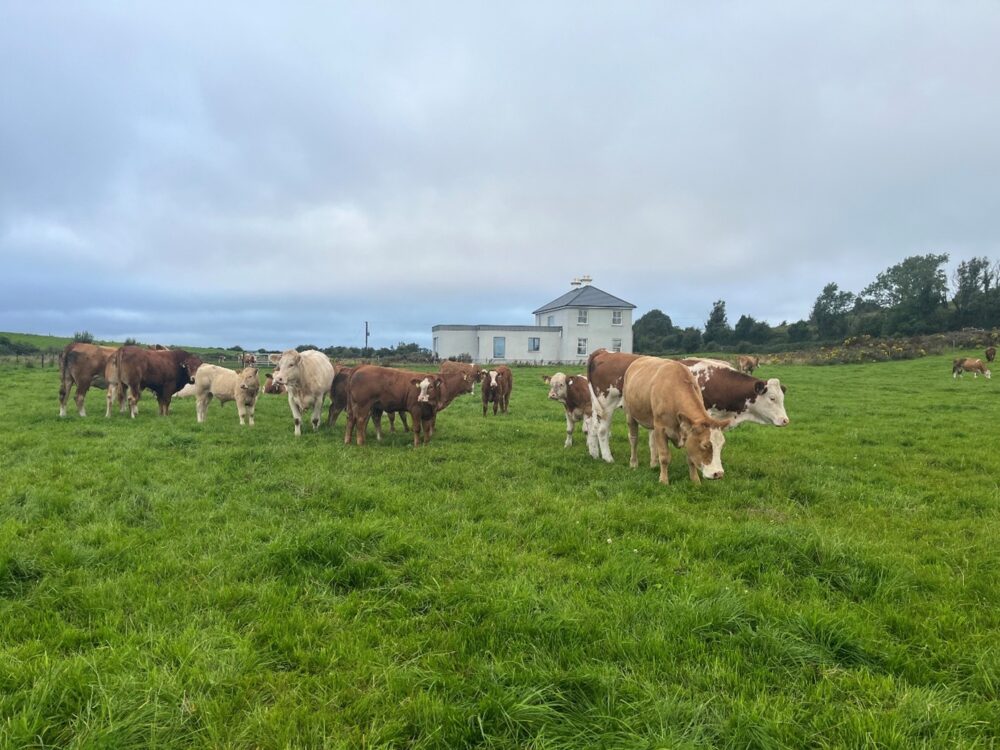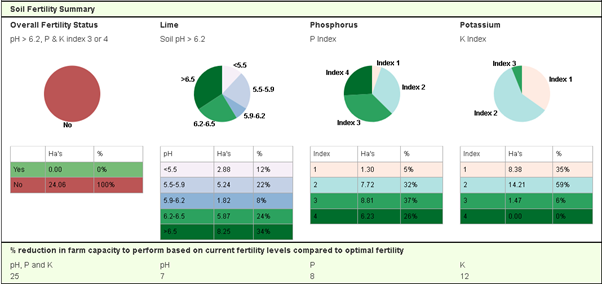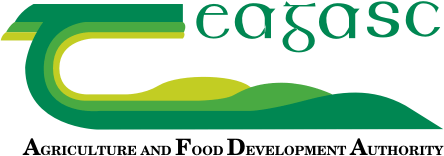Breeding
Cathal has the Limousin and Charolais bull running together with the cows and they did not fight when mixed. He scanned on 19th July and there are 18 cows (including heifers) in calf out of 21 that were bred with the bull. A further 2 cows were not long enough bred to know if they were in calf, so they will be scanned again in the next month, so Cathal is hoping for 20 out of 21 cows in calf. One further cow has a tumour and was not bred, and one was previously picked for culling and was not bred either.
The expected calving dates for 2026 run from 4th February to 16th April at present which Cathal is very happy with as it amounts to 10 weeks in total.
The heifer calves are getting strong so Cathal will look at separating them for the bulls soon in case any of them start cycling early and risk going in calf too young.

Figure 1: Cows and calves at grass
Cathal has been analysing his calving report for 2025. Calving started on 21st February and finished on 6th April, lasting 7 weeks in total. Ten cows and 8 heifers calved during that time.
The calving interval is longer for the herd this year at 397 days, but this is deliberate on Cathal’s part as he has been gradually pushing out the calving date every year to calve the herd closer to grass so that they spend less time in the shed. He is happy with the average calving date of 21st February that was achieved this year, so will be back to targeting 365 days next year.
Aside from this, his other breeding KPI’s are excellent. He lost no calves this year and had two sets of twins so had 0% mortality up to 28 days. This left him with 1.02 calves per cow per year, well ahead of the target 0.95 and national average of 0.84.
Cathal calves him home bred heifers at 2 years of age but as he had bought in some heifers, 63% of this year’s heifers calved at 22-26 months of age. Again he is well ahead of the national figure of 22%. The spring 6 week calving rate was 94% this year, which is attributed to the synchronisation programme that Cathal carried out in 2024. This is well ahead of the target of >70% and the national average of 57%. Overall he is very happy with his performance this year.
Financial
Cathal completed his profit monitor for 2024. On analysis of the cattle detailed report, he is happy with the farm’s financial and physical performance this year.
The first figure on the report is the output per livestock unit which was 390.9 kg/LU. This was a significant increase from 2023 where the figure was 331.5 kg/LU, and is well ahead of the target >350 kg/LU for a suckler system. This figure is affected by everything that affects weight gain in the herd – the cow fertility, bull fertility, mortality, genetics, nutrition at grass, winter performance, ration fed, animal health and calving spread. Cathal has been focusing on increasing output with the bull beef system and through genetics.
The stocking rate on the farm is 1.52 LU/ha or 115 kg organic N/ha which means that Cathal is not in derogation.
The gross output figure is calculated from cattle sales minus cattle purchases and add/subtract any changes to the inventory. Cathal had a gross output figure of €1314/ha which is the main ‘money in the pot’ to cover variable and fixed costs. This reduced from €1380/ha in 2023 due to the 15 bought in bulls for finishing in September 2024.
The 3 biggest expenses on drystock farms are purchased concentrate, fertiliser and contractor costs. Cathal’s farm is no different with his biggest costs for the year;
- Ration €644/ha (increase of €342/ha since 2023)
- Contractor: €357/ha (decrease of €34/ha since 2023)
- Fertiliser: €257/ha (increase of €195/ha since 2023)
In total, the total variable costs (€1603/ha) were 122% of the gross output figure, which is much higher than the target of <55% for a bull beef system. However the purchased cattle had an impact on this in the inventory and extra ration fed to the bulls.
The fixed costs were €1203/ha for 2024 which is higher than 2023. Depreciation increased due to the significant investment into the new shed and yard, but machinery depreciation remained the same.
Soil Fertility
Cathal took soil samples for the farm in spring 2025. The results showed that 75t of lime is required over the next 2 years to rise the soil pH above 6.2, Currently, 58% of the farm has a soil pH of 6.2 or higher – which is critical for releasing phosphorus and optimising grass growth on the farm. Cahal will spread 60t of lime across the farm in 2025 to help improve this.
The phosphorus index shows that 63% of the farm is at index 3 or higher which is great. Slurry and 18-6-12 is key to rising this percentage across the rest of the farm. As Cathal is now finishing bulls with high ration input, they are producing high quality slurry that can be targeted on high offtake silage fields and low index fields for the best response.
The potassium (K) index is very low across the farm, with only 6% of the farm in index 3 and none in index 4. However is a simple nutrient to build up in the form of muriate of potash which consists of 50 units of potassium per bag. There is no restriction on how much potassium can be applied on a farm, or when it can be spread, so Cathal has the option of spreading it any time the ground is fir to travel. In order to avoid any tetany issues in autumn, a half bag per acre can be spread (25 units/acre) across the farm.

Figure 2: Soil fertility status of Cathal’s farm
Based on the soil sample results, Cathal’s local advisor Shane has developed a nutrient management plan for the farm which indicates the fields that require lime, P and K and at what rate. It also outlines Cathal’s nitrogen and phosphorus allowances for the year to ensure that he stays within the fertiliser limits.
Cathal is also using a soil conditioner on the farm. While the recommendation from the supplier is not to spread lime or chemical phosphorus across the farm, no Irish research is available for the product and Cathal is airing on the side of caution by continuing to do so, so that the soil fertility is not reduced over time.
